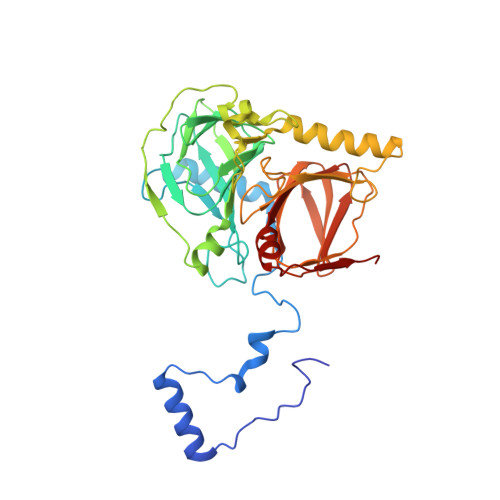The generation of a 1-hydroxy-2-naphthoate 1,2-dioxygenase by single point mutations of salicylate 1,2-dioxygenase - Rational design of mutants and the crystal structures of the A85H and W104Y variants.
Ferraroni, M., Steimer, L., Matera, I., Burger, S., Scozzafava, A., Stolz, A., Briganti, F.(2012) J Struct Biol 180: 563-571
- PubMed: 22960182
- DOI: https://doi.org/10.1016/j.jsb.2012.08.007
- Primary Citation of Related Structures:
4FAG, 4FAH, 4FBF - PubMed Abstract:
Key amino acid residues of the salicylate 1,2-dioxygenase (SDO), an iron (II) class III ring cleaving dioxygenase from Pseudaminobacter salicylatoxidans BN12, were selected, based on amino acid sequence alignments and structural analysis of the enzyme, and modified by site-directed mutagenesis to obtain variant forms with altered catalytic properties. SDO shares with 1-hydroxy-2-naphthoate dioxygenase (1H2NDO) its unique ability to oxidatively cleave monohydroxylated aromatic compounds. Nevertheless SDO is more versatile with respect to 1H2NDO and other known gentisate dioxygenases (GDOs) because it cleaves not only gentisate and 1-hydroxy-2-naphthoate (1H2NC) but also salicylate and substituted salicylates. Several enzyme variants of SDO were rationally designed to simulate 1H2NDO. The basic kinetic parameters for the SDO mutants L38Q, M46V, A85H and W104Y were determined. The enzyme variants L38Q, M46V, A85H demonstrated higher catalytic efficiencies toward 1-hydroxy-2-naphthoate (1H2NC) compared to gentisate. Remarkably, the enzyme variant A85H effectively cleaved 1H2NC but did not oxidize gentisate at all. The W104Y SDO mutant exhibited reduced reaction rates for all substrates tested. The crystal structures of the A85H and W104Y variants were solved and analyzed. The substitution of Ala85 with a histidine residue caused significant changes in the orientation of the loop containing this residue which is involved in the active site closing upon substrate binding. In SDO A85H this specific loop shifts away from the active site and thus opens the cavity favoring the binding of bulkier substrates. Since this loop also interacts with the N-terminal residues of the vicinal subunit, the structure and packing of the holoenzyme might be also affected.
Organizational Affiliation:
Dipartimento di Chimica "Ugo Schiff", Università di Firenze, Via della Lastruccia 3, I-50019 Sesto Fiorentino-FI, Italy. [email protected]

















